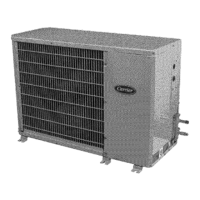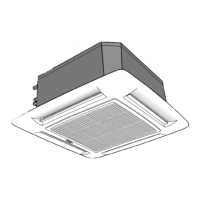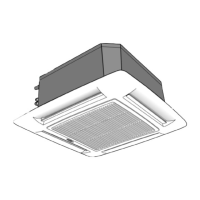Do you have a question about the Carrier 40KMC---N and is the answer not in the manual?
Power input for cooling and heat pump modes across various sizes.
Specifications for optional electric heaters, including capacity and supply.
Lists the included installation and operational components.
Defines acceptable voltage and temperature ranges for operation.
Lists parts and materials needed for a complete setup.
Key instructions and safety precautions for unit installation.
Guidance on choosing an appropriate location, avoiding unsuitable conditions.
Steps before installation, including unit handling and ceiling considerations.
Creating wall openings and connecting refrigerant pipes.
Attaching the unit's grille and frame assembly.
Proper installation and routing of the condensate drain pipe for water evacuation.
Detailed steps for making refrigerant pipe connections to the unit.
Correct methods for flaring pipe ends to ensure secure connections.
Information on additional refrigerant requirements for extended pipe lengths.
Procedures for verifying leak-tightness and drain path functionality.
Identification of terminal blocks and connectors on control panels.
Schematic representations for electrical connections and system wiring.
Guidelines for routing and securing of electrical cables.
Instructions for installing the fresh air intake grille and associated components.
Methods for ducting conditioned air to an adjacent room.
Guidelines for incorporating fresh air at appropriate rates.
Specifics for delivering conditioned air to other rooms via ducts.
Configuring the unit for cooling-only operation modes via remote control.
Configuring the unit for heat pump operation modes via remote control.
Setting up the system for multi-split or T-Kit installations.
Adjusting specific settings on the remote controller itself.
Procedure to verify unit functionality and performance after installation.
Assigning unique addresses to indoor units for independent remote control.
Configuring unit addresses for independent operation of multiple units.
Visual fault signals and the function of the emergency push-button.
Understanding error codes indicated by the unit's LEDs for troubleshooting.
How to operate the unit in a basic mode using the emergency button.
Basic instructions for the end-user on operating and maintaining the unit.
Power input for cooling and heat pump modes across various sizes.
Specifications for optional electric heaters, including capacity and supply.
Lists the included installation and operational components.
Defines acceptable voltage and temperature ranges for operation.
Lists parts and materials needed for a complete setup.
Key instructions and safety precautions for unit installation.
Guidance on choosing an appropriate location, avoiding unsuitable conditions.
Steps before installation, including unit handling and ceiling considerations.
Creating wall openings and connecting refrigerant pipes.
Attaching the unit's grille and frame assembly.
Proper installation and routing of the condensate drain pipe for water evacuation.
Detailed steps for making refrigerant pipe connections to the unit.
Correct methods for flaring pipe ends to ensure secure connections.
Information on additional refrigerant requirements for extended pipe lengths.
Procedures for verifying leak-tightness and drain path functionality.
Identification of terminal blocks and connectors on control panels.
Schematic representations for electrical connections and system wiring.
Guidelines for routing and securing of electrical cables.
Instructions for installing the fresh air intake grille and associated components.
Methods for ducting conditioned air to an adjacent room.
Guidelines for incorporating fresh air at appropriate rates.
Specifics for delivering conditioned air to other rooms via ducts.
Configuring the unit for cooling-only operation modes via remote control.
Configuring the unit for heat pump operation modes via remote control.
Setting up the system for multi-split or T-Kit installations.
Adjusting specific settings on the remote controller itself.
Procedure to verify unit functionality and performance after installation.
Assigning unique addresses to indoor units for independent remote control.
Configuring unit addresses for independent operation of multiple units.
Visual fault signals and the function of the emergency push-button.
Understanding error codes indicated by the unit's LEDs for troubleshooting.
How to operate the unit in a basic mode using the emergency button.
Basic instructions for the end-user on operating and maintaining the unit.
| Brand | Carrier |
|---|---|
| Model | 40KMC---N |
| Category | Air Conditioner |
| Language | English |











